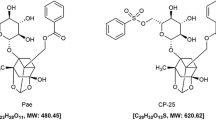Abstract
The urinary and faecal excretion of chrysene and its phenolic metabolites after oral, intraperitoneal, intratracheal, and intrapulmonary administration to rats have been studied by means of gas chromatography/mass spectrometry. The metabolite profile was found to depend on the mode of excretion and on the route of administration. In all cases the oxidation of chrysene in the 1,2- or 3,4-position predominates, whereas oxidation in the 5,6-position (K-region) seems be a minor pathway.
Similar content being viewed by others
References
Berenblum I, Schoental R (1949) The metabolism of chrysene: the isolation of 3-methoxychrysene by methylation of the phenolic metabolites of chrysene from rat faeces. Biochem J 44: 604–606
Boyland E, Sims P (1965) Metabolism of polycyclic compounds. The metabolism of 9,10-epoxy-9,10-dihydrophenanthrene in rats. Biochem J 95: 788–792
Chou MW, Fu PP, Yang SK (1981) Metabolic conversion of dibenz(a,h)-anthracene (±) trans-1,2-dihydrodiol and chrysene (±) trans-3,4-dihydrodiol to vicinal dihydrodiol epoxides. Proc Natl Acad Sci USA 78: 4270–4273
Harper KH (1959) The intermediary metabolism of polycyclic hydrocarbons. Br J Cancer 13: 718–731
Hodgson RM, Pal K, Grover PL, Sims P (1982) The metabolic activation of chrysene by hamster embryo cells. Carcinogenesis 3: 1051–1056
Hodgson RM, Weston A, Grover PL (1983) Metabolic activation of chrysene in mouse skin: evidence for the involvement of a triol-epoxide. Carcinogenesis 4: 1639–1643
Hodgson RM, Seidel A, Bochnitschek W, Glatt HR, Oesch F, Grover PL (1985) The formation of 9-hydroxychrysene-1,2-diol as an intermediate in the metabolic activation of chrysene. Carcinogenesis 6: 135–139
Hodgson RM, Weston A, Seidel A, Bochnitschek W, Glatt HR, Oesch F, Grover PL (1986) Metabolism of chrysene to triols and a triol-epoxide in mouse skin and rat liver preparations. In: Cooke M, Dennis AJ (eds) Polynuclear aromatic hydrocarbons. Battelle Press, Columbus/Ohio, pp 387–399
IARC Monographs on the evaluation of the carcinogenic risk of chemicals to humans. Polynuclear Aromatic Hydrocarbons, Part 1, Chemical, Environmental and Experimental Data. Vol 32, Lyon (1983)
Jacob J, Schmoldt A, Grimmer G (1982) Formation of carcinogenic and inactive chrysene metabolites by rat microsomes of various monooxygenase activities. Arch Toxicol 51: 255–265
Jacob J, Karcher W, Grimmer G, Schmoldt A, Hamann M (1986) The influence of various monooxygenase inducers on rat liver microsomal chrysene oxidation. In: Cooke M, Dennis AJ (eds) Polynuclear aromatic hydrocarbons. Battelle Press, Columbus/Ohio, pp 417–426
Jacob J, Schmoldt A, Hamann M, Raab G, Grimmer G (1987) Mono-oxygenase induction by various xenobiotics and its influence on rat liver microsomal metabolism of chrysene in comparison to benz(a)anthracene. Cancer Lett 34: 91–102
Jacob J, Grimmer G, Raab G, Emura M, Riebe M, Mohr U (1987) Comparison of chrysene metabolism in epithelial human bronchial and Syrian hamster lung cells. Cancer Lett 38: 171–180
Jongeneelen FJ (1987) Biological monitoring of occupational exposure to polycyclic aromatic hydrocarbons. PhD thesis. CIP-Data Koninklijke Bibliotheek, Den Haag. 181 pp
Jongeneelen FJ, Anzion RBM, Henderson PT (1987) Determination of hydroxylated metabolites of polycyclic aromatic hydrocarbons in urine. J Chromatogr 413: 227–232
MacNicoll AD, Grover PL, Sims P (1980) The metabolism of a series of polycyclic hydrocarbons by mouse skin maintained in short term organ culture. Chem-Biol Interact 29: 169–188
Nordqvist M, Thakker DR, Vyas KP, Yagi H, Levin W, Ryan DE, Thomas PE, Conney AH (1981) Metabolism of chrysene and phenanthrene to bay-region diol epoxides by rat liver enzymes. Mol Pharmacol 19: 168–178
Saffiotti U, Cefis F, Kolb LH (1968) A method for the experimental induction of bronchogenic carcinoma. Cancer Res 28: 104–124
Sims P (1970) Qualitative and quantitative studies on the metabolism of a series of aromatic hydrocarbons by rat liver preparations. Biochem Pharmacol 19: 795–818
Sims P, Grover PL (1974) Epoxides in polycyclic aromatic hydrocarbon metabolism and carcinogenesis. Adv Cancer Res 20: 165–274
Stanton MF, Miller E, Wrench C, Blackwell R (1972) Experimental induction of epidermoid carcinoma in the lungs of rats by cigarette smoke condensate. J Natl Cancer Inst 49: 867–877
Vyas KP, Levin W, Yagi H, Thakker DR, Ryan DE, Thomas PE, Conney AH, Jerina DM (1982) Stereoselective metabolism of the (+)- and (−)-enantiomers of trans-1,2-dihydroxy-1,2-dihydroxychrysene to bay region 1,2-diol-3,4-epoxide diastereomers by rat liver enzymes. Mol Pharmacol 22: 182–189
Author information
Authors and Affiliations
Additional information
The present study was carried out by the order of the Federal Ministry for Research and Technology (BMFT)
Rights and permissions
About this article
Cite this article
Grimmer, G., Brune, H., Dettbarn, G. et al. Urinary and faecal excretion of chrysene and chrysene metabolites by rats after oral, intraperitoneal, intratracheal or intrapulmonary application. Arch Toxicol 62, 401–405 (1988). https://doi.org/10.1007/BF00288341
Received:
Revised:
Accepted:
Issue Date:
DOI: https://doi.org/10.1007/BF00288341




